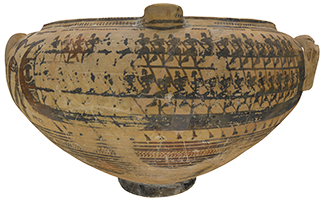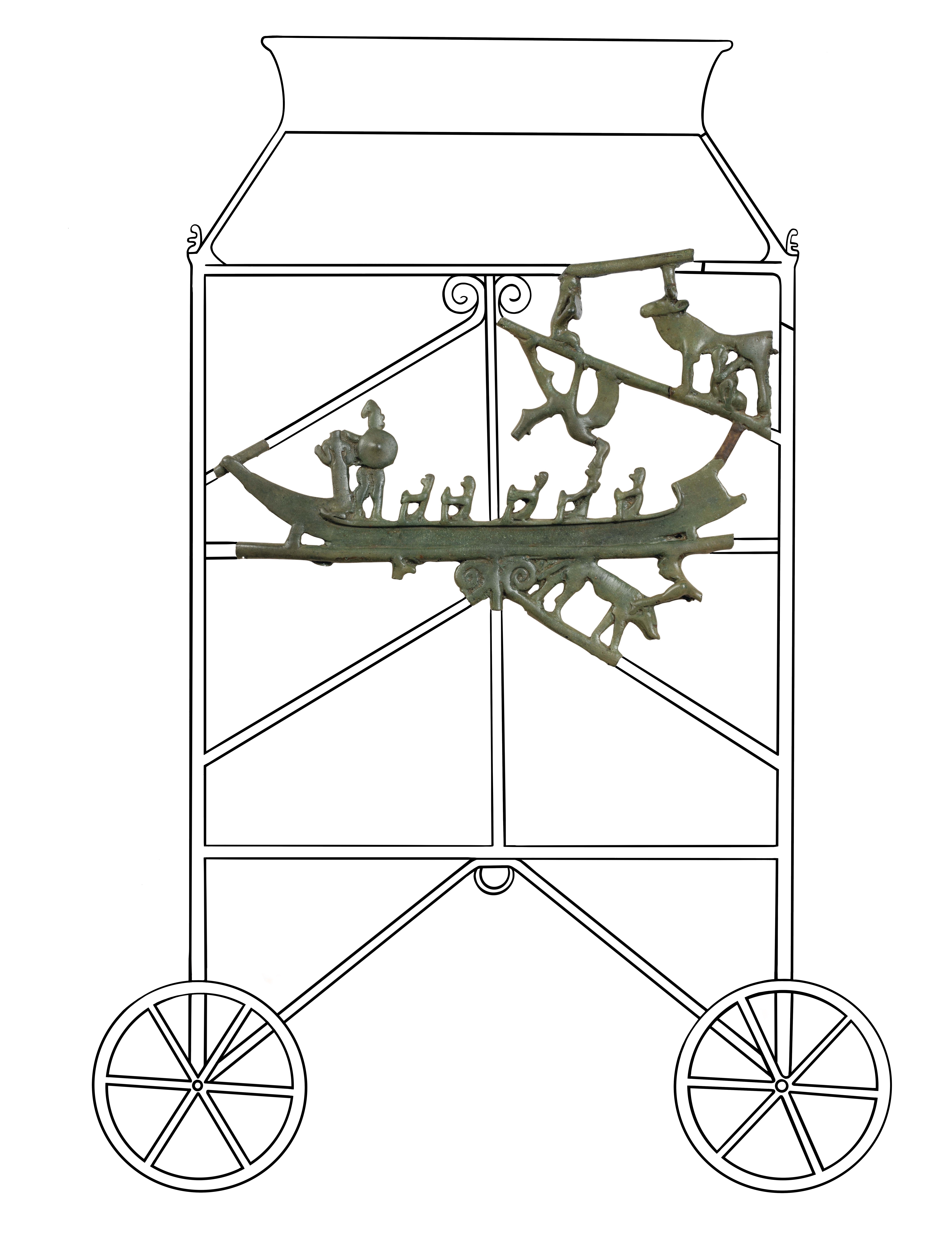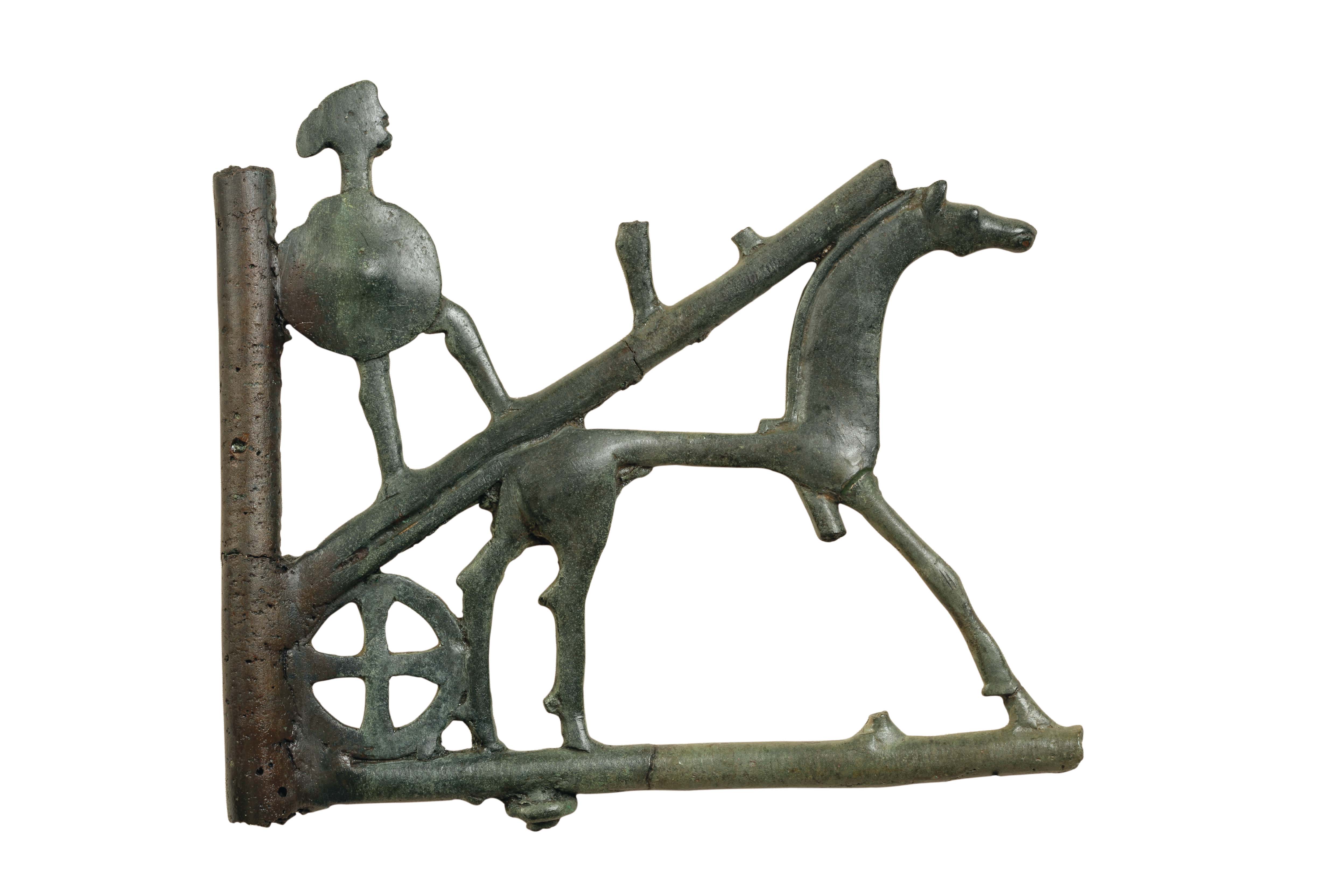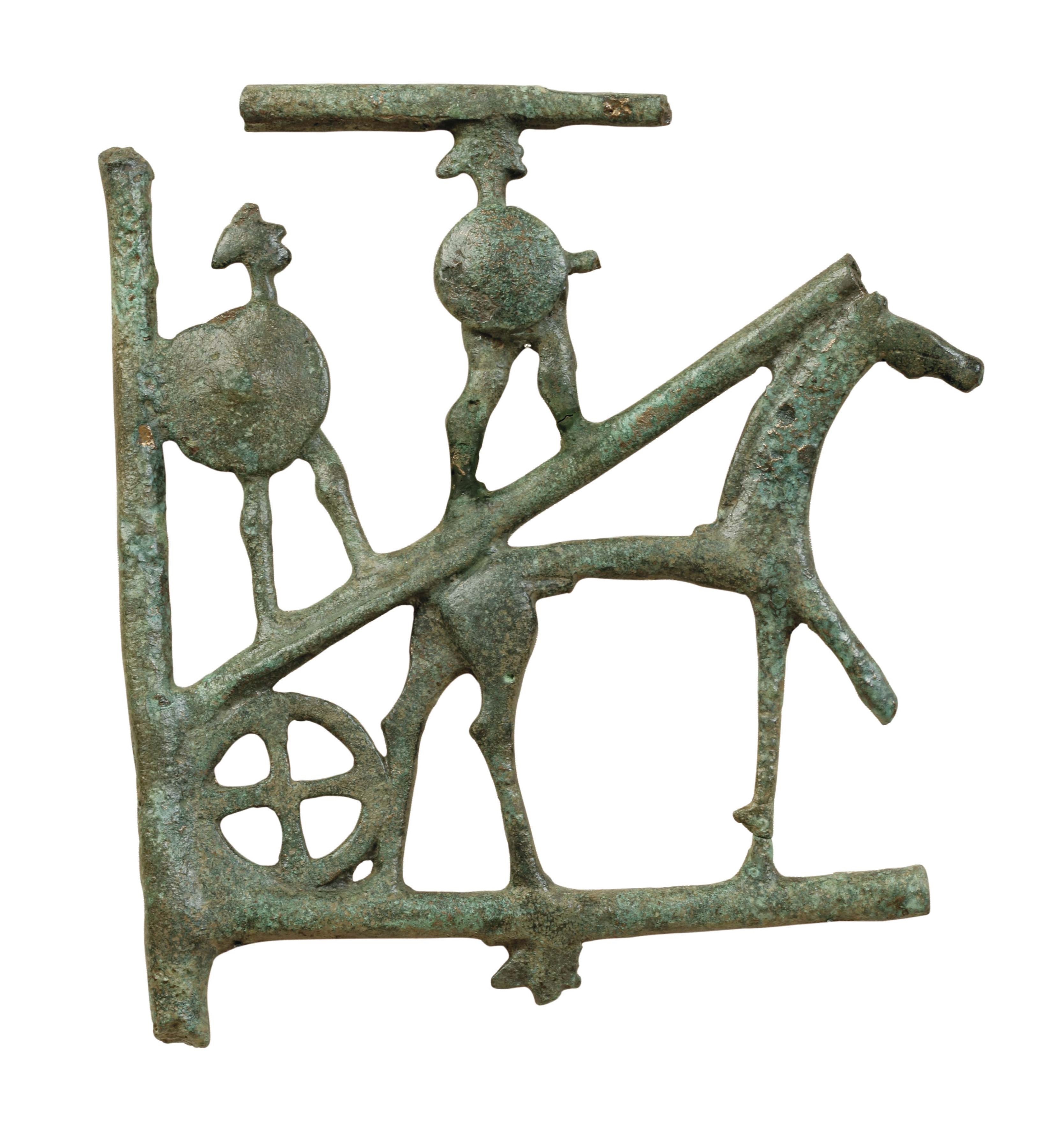Single levelled ship to the right with a low flat hull, a massive square bow with a vertical stempost integrating the bow projection, and a curving sternpost. The forecastle is solid and square much like the ones depicted on figural pottery. The bow projection is particularly short. There are no decorative devices on either post. Following the contour of the gunwale is an additional horizontal feature that clearly extends outwardly from the hull proper. This piece begins from the upper inner edge of the forecastle whose accentuated curve it espouses closely, and ends in a gentler curve near the beginning of the sternpost. This detail, otherwise much more difficult to interpret in pictorial representations, is a unique contribution of the medium's three-dimensionality. Basch interprets this feature as an outrigger, which also appears to be used for embarking/disembarking from the vessel. The five rower face left sitting at gunwale level, their torsos upright, their hands grasping at their oars held in a vertical position.
Departure scene
A52
LG
Idaean Cave, Crete
H (max): 26.3 cm; L (max): 37 cm; length of horizontal rod: 32.3cm; diameter of horizontal rods: ca. 1.0 cm; of diagonal struts: 0.85 cm.
Four-sided stand: estimated height: ca. 60-65 cm; width: ca. 40 cm; ring diam.: ca. 20 cm
Four-sided bronze stand of Cretan manufacture found in multiple fragments, first partially recovered in 1884, with additional fragments found by Sakellarakis in 1982-1986.
Basch 1987: 173, 175-76, nos. 364, 365a-b; Dimopoulou-Rethemiotaki 2005: 398; Maraghiannis et al 1912: XLII, pl. 11; Orsi and Halbherr 1888: 41-42, nos. 2-3, 44, no. 13, pl. XI:1, 5; Papasavvas 2012: 152, figs. 6,7; Rizzo 1984: 28, fig. 5; Rolley 1977:110, no. 1, figs. 40-41; Spathari 1995:68-69, fig. 76. main studies: Matthäus 2014: 79-84, no. IC 16; Papasavvas 2001: 249-52, no. 48 α, figs. 132-145.
During the LBA and EIA, rod tripods and four-sided stands of Cypriote type were disseminated and incorporated into the metal industries of other Mediterranean regions including the Levant, the Aegean, and even Sardinia. Although these regional examples follow the types and techniques of the Cypriot originals, they nonetheless display important structural and morphological characteristics that attest to localized traditions in manufacturing. Crete appears to have enjoyed a pivotal role in this process, as it was the main centre of production outside of Cyprus. Besides the remarkable concentration of these stands on Crete itself, the majority of the exemplars from non-Cretan Aegean contexts are furthermore attributable to Cretan workshops (Delphi, Thera, Rhodes). In addition to being distinguishable by local structural and stylistic peculiarities, these Cretan examples date to the EIA, whereas the Cypriot specimens are overwhelmingly of LBA date. Their find context includes tombs (with a high concentration around Knossos) and several distant Cretan cult places which enjoyed intra-regional importance (Syme, Idaean Cave, Amnisos, Palaikastro). About two thirds of the Cretan stands are from cultic contexts, with nearly all of the four-sided stands restricted to sanctuaries. There is evidence that the stand A52 was not the only object of this type dedicated at the Idean cave, since a fragment of a stand’s ring and stand wheels have also been found (Matthäus 2014: nos. IC 21, nos. IC 17-20).
Idaean Cave: The sacred cave of Zeus was arguably the most prominent cult place on the island of Crete in Antiquity. An extra-urban sanctuary situated high on mount Ida overlooking the Nida plateau which was largely uninhabited, the cave was only accessible in the summer season and was far away from large centres such as Knossos. Activity at the site goes back to the third millennium or even earlier (Vasilakis 2006), continued during Minoan times and across the LBA-EIA transition (Stampolidis and Kotsonas 2013: 191), and peaked in the Geometric period. Activity then continued during the archaic period but on a reduced scale. The sanctuary had an interregional function - the abundance of finds of a large variety of types and styles, combined with their parallels from other Cretan sites indicates that the cave was widely visited by pilgrims coming from various parts of the island (Prent 2005, 559-604; Stampolidis and Kotsonas 2006: 347-349). While modest votives from non elite visitors are also attested, the site stands out for the incredible richness of its assemblage as well as the remarkably high number of imported objects from the Near East, pointing to an important elite clientele. These include cauldrons and bronze shields, ivories from north Syrian and Phoenician workshops, Egyptian lotus jugs and situlae, as well as a more limited assemblage of Cypriote metal bowls and tripods. Metal objects of Cretan craftsmanship meanwhile exhibit particularly eclectic styles, merging local and foreign elements inspired from Near Eastern art. The sanctuary has also provided specific classes of bronze objects which may allude to the mythological story of young Zeus protected by the Kouretes, such as the elaborate bronze shields and a bronze tympanum in an Assyrian style (Her. Arch. Mus. 9). Compared to metal, the quantity of EIA pottery from the site is limited (Sakellarakis and Sapouna-Sakellaraki 2011: 143). The exceptionally rich assemblage of votives of various materials and types includes: pottery vessels; clay and bronze figurines; bronze vessels, tripods and other utensils; gold, silver, and bronze ornaments; sealstones; iron weapons, ivories, and exotica in glass and. Some of these finds are otherwise unknown from similar contexts (Stampolidis and Kotsonas 2013: 193 with references). Compared to other Cretan contexts and sanctuaries, EIA Cretan cave sanctuaries show a concentration of images of Near Eastern deities, often crafted using rare and exotic materials (ivory, faience) that needed to be imported and are in general rarely found on the island. In the case of the Idaean Cave, these imports have been interpreted as evidence for the introduction of Near Eastern rituals (Sakellarakis 2006; Galanaki 2006; Stampolidis 2011).
Four-sided stands: Similarly to rod tripods to which they likely had a comparable function, four-sided strands originate from Cypriot workshops of the 13th-12th centuries B.C. Their construction consists of a rectangular frame mounted on feet or on wheels and crowned by a ring intended for supporting a vase. By their nature these allowed for a great variety of uses since the vases for which they acted as support were independent, separate units. The wheeled variety, with its axles inserted in loops at the bottom of the side posts, tends to be large (ca. 19-35 cm high), while the simpler versions without wheels are usually miniatures (ca. 10-17 cm high). The stands are richly decorated, with the rectangular frame typically enclosing figural decoration either in relief or ajourée technique, while the ring is decorated with ornament or an animal relief frieze. The themes of their figural decoration, including processions, offering scenes, mythical creatures, and animal combat, suggests a cultic function, providing support for vessels plausibly used for libation or the burning of aromatics. The Cypriot examples of four-sided strands unfortunately do not come from precisely dated contexts, with stone mould finds pointing to Enkomi and Hala Sultan Tekke as production centres, while exports are known from the Levant (Megiddo, Tel Miqne/Ekron) and the Aegean. On Crete, local imitations of rod tripods and four-stranded stands emerge as a replacement for Cypriot originals whose production seems to have ended around the 12th century B.C. (LC IIIA). The earliest specimens are an imitation in clay with a Minoan style decoration from the LM IIIC settlement of Karphi, as well as a very fragmentary burnt bronze Cypriot import from tomb 201 of the North Cemetery of Knossos dating to the SM period (Matthäus 2014:89-90).
Four-sided tripod stands of local Greek craftsmanship are known primarily from sanctuaries (Kato Syme, Delphi, Ialysos, Amnisos). The stand from the Idaean cave finds close parallels from the rich tomb of Khaniale Tekke (Hutchinson and Boardman 1954, pl. 30 left) and from the sanctuary of Zeus Thenatas at Amnisos, as well as two additional closely related examples from Delphi and a third from Rhodes. Papasavvas argues that all of these were produced in the same workshop operating during the 8th century B.C., most likely Knossian (Papasavvas 2001: 192-93). The Knossian associations of the Idaean cave in particular have been widely noted, including comparable luxury artefacts such as bronze jugs with lotus-handles, faience and ivory items, and gold artefacts with orientalising motifs. The presence of Cretan stands and other elaborate bronze in Delphi, Olympia and elsewhere indicate that Cretans were actively participating in Panhellenic networks. According to Matthäus, A52 dates to the tail end of the local Cretan production, displaying a figural style that has considerably diverged from the earlier 9th century examples from Kato Syme. Arguing for a significant change if not a break in artistic models, he sees a strong dependence on Attic art of the Late Geometric period for its iconography and style (Matthäus 2014: 89).
A52: The stand is in the Cypriote tradition but of Cretan, likely Knossian manufacture. Matthäus has reconstructed it as a four-sided stand, with each side comprised of two broad rectangular registers which are framed by vertical and horizontal rods, the latter being slightly slenderer. These registers are divided into two panels by vertical rods, with each panel further divided by diagonal struts terminating in volutes. The vertical frames continue into the stand’s legs, but since no finials are preserved, the reconstruction of the legs remains uncertain. The size of the stand nonetheless suggests that the object was probably of the wheeled variety. A single preserved example indicates that the stand further had arch-shaped rods with small pendent rings, although no pendants survive. The ring itself is missing, while diagonal struts were fixed on the upper corners of the stand to support it. The single surviving example of such a strut has a small human figure looking outwards placed at the junction. The stand is made up of rods of varying diameter, with both rods and figures soldered together using a similar technique. Most of the figures are cast in relief with a flat back, while a few are round. Matthäus cautions that it is uncertain whether all the fragments presented by him belong to the same stand, with further fragments of rods and figures held at the Heraklion Museum requiring a detailed re-examination. Detailed fragment descriptions below are drawn from Matthäus 2014: 79-84, no. IC 16.
Fragment A: Largest extant fragment, from the upper register and parts of the lower right panel. The main composition below is a naval scene of a hoplite armed with a round shield and helmet embarking a woman aboard a galley with five rowers. The woman is dressed in a long robe with upraised hands, her head missing. The man is shown grasping her hand, seemingly leading her onto the ship. The vertical rod dividing the panel, of which only traces on the back of the ship survive, was centered in the middle of the ship between the second and third oarsman from the left, thus simultaneously functioning as the ship’s mast. In the upper right corner of the composition is a bird soldered to the head of the second oarsman from the right, shown with a flat wing, tail and one leg preserved. Above it, on top of the right diagonal strut is a figure milking a cow facing left. Opposite them is a crouching figure facing right, holding an object (interpreted as a tambourine by Rolley, ‘άρτος’ by Papasavvas). Below the ship, the upper right corner of the lower horizontal register preserves a figure holding a dog by the neck. To the left underneath the horizontal rod is the head of an animal.
Fragment B: Her. Arch. Mus. X 1636 and 1637. Left part of a lower register, with an arch-shaped strut and a pendant ring below it. Height (max): 18.5 cm; diameter of horizontal rods: 1.1 cm; of diagonal strut: 0.9 cm; of vertical rod: 0.8 cm. On the top left corner standing on a diagonal strut, a running archer aiming at an animal (lost, one foot visible). Below it is a sphinx facing right, cast in the round. Foot of an animal to the right of the vertical rod, possibly another sphinx or a human, placed antithetically.
Fragment C: Her. Arch. Mus. X 185. Fragment of an upper left panel. Height of panel: 19 cm, diameter of vertical frame: 1.0- 1.3 cm; of horizontal rods: 0.85 cm. On the top left corner standing on a diagonal strut, two warriors with round shield and helmets facing right. The right warrior carries a lance. Below is a horse and a four-spoked wheel serving as an abbreviation for a chariot. Parts of a helmeted head below the lower horizontal rod. Fragment D: Her. Arch. Mus. X 1635. Very similar to fragment C but in a worse state of preservation. Fragment E: Her. Arch. Mus. X 188. Preserved length: 13.7 cm; length of figure: 11.5 cm; height of figure: 6 cm. Figure of quadruped (possibly a dog) facing right. Fragment of a second figure of a quadruped (horse?) below. Fragment F: Her. Arch. Mus. X 187. Length of figure: 9 cm; height: 6.5 cm. Dog with a collar facing right. Fragment G: Her. Arch. Mus. X 193. Greatest length: 10 cm A warrior with round shield throwing a spear, facing left. Fragment H: Her. Arch. Mus., unnumbered. Fragment of two helmeted warriors with a round shield throwing a spear. Fragment I: Her. Arch. Mus., unnumbered. Height of figure: 6 cm. Hind legs and long tail of horse. Fragments J-L: Her. Arch. Mus., unnumbered. Maximum height: 10 cm. Fragments of two warriors with round shields, one of them holding a lance. They face left and right respectively, and probably stood on diagonal struts. Fragments M: Her. Arch. Mus. X 1638. Fragment from the lower right corner of an upper register. Greatest height of figure: 9.1 cm. Female figurine in a long robe, her head to the left and arms uplifted, holding a knife in her right hand. Below the horizontal rod on which she stands is the head od another figure with a horizontal headdress on which three round objects are recognizable. Above her on a diagonal strut are traces of two human feet. Fragments N: Her. Arch. Mus. X 199. Upper part of long-haired nude human figure with outstretched arms, possibly female. Fragments O: Her. Arch. Mus., unnumbered. Greatest length: 19 cm; section of diagonal strut: 1 x 1.9 cm; length of vertical frame: 12.0 cm, diameter of vertical frame: 1.2 cm; of horizontal rods: 0.9 cm. Upper corner of the stand, including the vertical frame below joined by a rod to the left and right in addition to a diagonal angular strut which connected the four-sided part of the stand with the ring which carried the vase. At the junction of the different parts is a small sitting human figure holding a vessel. Fragment P: Her. Arch. Mus., unnumbered. Length of small animal: 4 cm. Small animal facing right, leg of a larger animal behind. According to Papasavvas, there was the head and horn of a wild goat or ibex below the rod. Fragment Q: Nation. Arch. Mus. 18223. Greatest height: 6.5 cm; greatest length: 4.3 cm. Fragment of a stag facing right. Fragment R: Her. Arch. Mus., unnumbered. Human head cast in the round, similar to the sphinx of fragment B, possibly from the opposite panel of the same register. Fragments S-U: Her. Arch. Mus., unnumbered. Three fragmentary figures including a warrior with helmet and shield, the head of a helmeted warrior, and parts of a bird comparable to the one on fragment A.The placement of the ship scene made clever use of the structural elements of the stand. Thus the vertical rod would have stood in place of the mast, while the two diagonal struts simulate the fore and backstay. Following this visual logic, even the volute terminals of the vertical rod can give the impression of deadeyes.
A52 is the only example of a ship scene on this medium. The scene however finds extremely close parallels in two other objects: the ivory plaque from the sanctuary of Artemis Orthia (A78) and an Attic krater of the Sub-Dipylon Group found in Thebes (A153). In all three examples, a couple is shown boarding a manned galley, the man grasping the hand of the woman which is shown wearing a long skirt. It is notable that the two objects with a well-known context both come from sanctuaries and occur on elite objects of considerable craftsmanship. The theme likely depicts a well-known mythological scene which was popular in the late 8th century B.C.
Given the lack of written sources, it is impossible to ascertain the level of continuity of a specific cult, such as a change in deities from the Minoan to the Geometric period. Aside from Cretan Zeus, the possibility of a female cult has been raised (Prent 2005; Byrne 1991: 81, 203). This is an intriguing possibility considering the prominence of female figures on the stand, and the fact that one of its close parallels comes from the sanctuary of Artemis at Sparta.
Basch, L. 1987. Le musée imaginaire de la marine antique. Athens: Institut Hellénique pour la preservation de la tradition nautique.
Byrne, M. 1991. The Greek Geometric Warrior Figurine: Interpretation and Origin. Louvain-la-Neuve.
Dimopoulou-Rethemiotaki, N. 2005. The Archaeological Museum of Herakleion. Athens: EFG Eurobank Ergasias S.A./John S. Latsis Public Benefit Foundation.
G. Maraghiannis, L. Pernier, G. Karo. 1912. Antiquités crétoises (Première Série). Cinquante planches par G. Maraghiannis. Texte de L. Pernier et G. Karo. Deuxième edition. Candie.
Galanaki, K. 2006. “Χάλκινεϛ Ανάγλυφεϛ Ομφαλωτέϛ Φιάλεϛ τηϛ Πρώιμηϛ Αρχαϊκήϛ περιόδου από το Ιδαίο Ἀντρο,” In: E. Γαβριλάκη and Y.Z. Τζιφόπουλοϛ (eds.)
Ο Μυλοπόταμοϛ από την Αρχαιότητα ωϛ Σήμερα . Vo. 3. Rethymno, pp. 85-136.
Matthäus, H. 2014. “Idaean Cave: Cypriote imports and Cretan objets d’art in Cypriote cultural tradition from the Cave of Zeus on Mount Ida” In: V. Karageorghis, A. Kanta, N. Chr. Stampolidis and Y. Sakellarakis (eds.) Kypriaka in Crete. From the Bronze Age to the end of the Archaic Period. Nicosia: A.G. Leventis Foundation, pp. 70-91.
Orsi P., F. Halbherr. 1888. Antichità dell' Antro di Zeus Ideo e di altre localita in Creta (estratto di antichita classica vol. II punt. III), Firenze.
Papasavvas, G. 2001. Χάλκινοι υποστάτες από την Κύπρο και την Κρήτη : τριποδικοί και τετράπλευροι υποστάτες από την Ύστερη Εποχή του Χαλκού εώς την Πρώιμη Εποχή του Σιδήρου [Bronze stands from Cyprus and Crete. Tripods and four-sided stands of the Late Bronze Age and early Iron Age]. Nicosia: A.G. Leventis Foundation.
―――. 2012. “Cretan Bronze Stands of Cypriot types from sanctuaries and Cemeteries: Cretan Society in the Early Iron Age,” in M. Iacovou (ed.) Cyprus and the Aegean in the Early Iron Age. The Legacy of Nicolas Coldstream. Nicosia: Bank of Cyprus Cultural Foundation, pp. 129-153.
Prent, M. 2005. Cretan Sanctuaries and Cults: Continuity and Change from the Late Minoan IIIC to the Archaic Period. Religions in the Graeco-Roman World 154. Leiden and Boston.
Rizzo M. A. 1984. “The First Explorations,” In: Ancient Crete, A Hundred Years of Italian Archaeology (1884-1984). Rome: De Luca Editore.
Rolley, Cl. 1977. Les trépieds à couve clouée. Fouilles de Delphes Vol. 3. Paris: Ecole Française d’Athènes.
Sakellarakis, Y. and E. Sapouna-Sakellaraki. 2011. Ιδαίο Ἀντρο: Το Σπήλαιο του Δία και οι ϴησαυροι του. . Athens.
Sakellarakis, Y.A. 2006. “Με Αφορμή Κάποια Λείψανα Επίπλων στο Ιδαίο Ἀντρο,” In: E. Γαβριλάκη and Y.Z. Τζιφόπουλοϛ (eds.) Ο Μυλοπόταμοϛ από την Αρχαιότητα ωϛ Σήμερα . Vo. 3. Rethymno, pp. 137-181.
Spathari, E. 1995. Sailing through Time: The Ship in Greek Art. Athens: Kapon Editions.
Stampolidis, N.C. 2011. “Eleutherna and the Idaean Cave. An attempt to Reconstruct Interactions and Rituals,” In: G. Rizza (ed.) Identità Culturale, Etnicità, Processi di Formazione a Creta fra Dark Age e Arcaismo. Convegno di Studi, Athens, 9-12 November 2006. Palermo, pp. 395-420.
Stampolidis, N.C. and A. Kotsonas. 2006. “Phoenicians in Crete,” In: S. Deger-Jalkotzy and I.S. Lemos (eds.) Ancient Greece: From the Mycenaean Palaces to the Age of Homer. Edinburgh: Leventis Studies 3, pp. 337-360.
Stampolidis, N.C. and A. Kotsonas. 2013. “Cretan Sanctuaries of the Early Iron Age to the Roman Period,” F. Mavridis and J.T. Jensen (eds.) Stable Places and Changing Perceptions: Cave Archaeology in Greece. BAR International Series 2558. Oxford: Archaeopress, pp. 188-200.
Vasilakis, A. 2006. “Το Ιδαίο Ἀντρο στη Μινωική Εποχή,” In: E. Γαβριλάκη and Y.Z. Τζιφόπουλοϛ (eds.) Ο Μυλοπόταμοϛ από την Αρχαιότητα ωϛ Σήμερα . Vo. 3. Rethymno, pp. 21-30.











